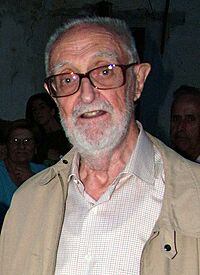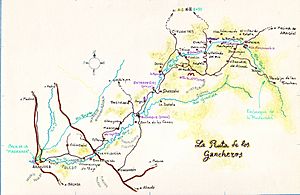José Luis Sampedro facts for kids
Quick facts for kids
José Luis Sampedro
|
|
|---|---|
 |
|
| Born |
José Luis Sampedro Sáez
1 February 1917 Barcelona, Spain
|
| Died | 8 April 2013 (aged 96) Madrid, Spain
|
| Citizenship | Spanish |
| Alma mater | University Complutense, Madrid |
| Occupation | Economist, writer |
| Known for | Human rights advocacy |
| Seat F of the Real Academia Española | |
| In office 2 June 1991 – 8 April 2013 |
|
| Preceded by | Manuel Halcón |
| Succeeded by | Manuel Gutiérrez Aragón |
José Luis Sampedro Sáez (born in Barcelona, Spain, on February 1, 1917 – died in Madrid, Spain, on April 8, 2013) was a famous Spanish economist and writer. He believed in an economy that was "more human" and "more caring." He wanted an economic system that would help people live with dignity.
Sampedro was a member of the Real Academia Española (Royal Spanish Academy) starting in 1990. This is a very important group that helps guide the Spanish language. He received many awards for his work, including the Order of Arts and Letters of Spain and the Spanish Literature National Prize. He also inspired the anti-austerity movement in Spain, which was a movement against strict government spending cuts.
Contents
About José Luis Sampedro
Early Life and Education
José Luis Sampedro was born in 1917. That same year, his family moved to Tangier in Morocco. He lived there until he was thirteen years old.
In 1936, when he was 19, he joined the Republican side during the Spanish Civil War. He fought in different parts of Spain. After the war, he worked as a customs officer in Santander.
Later, he moved to Madrid. In 1944, he married Elizabeth Pellicer. He also studied Economics at the university. He finished his studies in 1947 and even won a special award for his excellent work.
Career as an Economist and Teacher
After university, Sampedro started working for a big Spanish bank called Banco Exterior de España. At the same time, he began teaching at the university. In 1955, he became a professor of Economic Policy at the Complutense University of Madrid. He taught there until 1969. He also held important positions at the bank, eventually becoming a deputy general manager.
During these years, he wrote academic books about economics. He also wrote his first play, called A place to live, in 1955.
Around 1965, some university professors in Spain faced problems. Because of this, Sampedro decided to become a guest professor in England. He taught at the Universities of Salford and Liverpool.
When he returned to Spain, he took a break from Complutense University. He published a funny play called The Naked Horse. After the death of Francisco Franco in 1976, Sampedro went back to the Banco Exterior de España as an economic advisor. In 1977, King Juan Carlos appointed him as a senator. Later, he was elected as a senator and served until 1979.
Writing Career and Later Life
While working as an economist, José Luis Sampedro also wrote many novels. Even after he officially retired, he kept writing. Some of his most famous books include October, October, Etruscan smile, and Old siren. Sadly, his wife, Isabel Pellicer, passed away in 1986.
In 1990, he became a member of the Royal Spanish Academy. His first speech there was about his novel The old siren. This book is seen as a Spanish celebration of "life, love, and tolerance."
In 2003, Sampedro married writer and poet Olga Lucas. They spent part of the year in Tenerife, in the Canary Islands. The unique Dracaena draco trees and the volcano there inspired him to write The path of the dragon tree.
Sampedro was a strong believer in humanism. He often spoke out against what he saw as the negative effects of Neoliberalism and Capitalism on society. In 2011, he wrote the introduction to the Spanish version of the book Time for Outrage by Stéphane Hessel. This book was very important for the Anti-austerity movement in Spain.
José Luis Sampedro passed away on April 8, 2013, in Madrid. He was 96 years old.
Awards and Recognition
José Luis Sampedro received many honors for his contributions.
- In 2002, he became an honorary chairman of a Spanish telecommunications company called Sintratel. He shared this honor with Nobel Prize winner José Saramago.
- In 2008, he received the Medal of the Order of Charlemagne from Andorra.
- In 2009, he was given an Honorary Doctorate by the University of Seville.
- In 2010, he won the Menéndez Pelayo International Prize for his "many contributions to human thought."
- Also in 2010, the Spanish government awarded him the Order of Arts and Letters of Spain for his "outstanding literary career."
- In 2011, he received the Premio Nacional de las Letras Españolas, a very important national literature prize.
- In 2012, he received another Honorary Doctorate from the University of Alcalá.
Aranjuez in his Works

In his novel Royal Site, Sampedro describes the Royal Palace of Aranjuez and its beautiful gardens. He believed that Aranjuez was the "real and true" center of Spain. Aranjuez is also featured in his novel A river that leads. In this story, it's the end point for timber rafters who float wood down the Tagus River to sawmills.
José Luis Sampedro is remembered in Aranjuez. There is an adult education center and a conference room named after him.
His Works
José Luis Sampedro wrote many different kinds of books, including novels, short stories, plays, and non-fiction.
Novels
He wrote a trilogy called Los círculos del tiempo (The Circles of Time):
- Octubre, octubre (1981)
- La vieja sirena (1990)
- Real Sitio (1993)
Other novels include:
- La estatua de Adolfo Espejo (written 1939, published 1994)
- La sombra de los días (written 1947, published 1994)
- Congreso en Estocolmo (1952)
- El río que nos lleva (1961)
- El caballo desnudo (1970)
- La sonrisa etrusca (1985)
- El amante lesbiano (2000)
- La senda del drago (2006)
- Cuarteto para un solista (2011), written with Olga Lucas
Short Stories
He published collections of short stories:
- Mar al fondo (1992), with 10 stories.
- Mientras la tierra gira (1993), with 32 stories.
He also wrote an uncollected short story:
- "La balada del agua" (2008)
Plays
- La paloma de cartón (written 1948, printed 2007)
- Un sitio para vivir (written 1955, printed 2007)
- El nudo (1982)
Poems
- Días en blanco: Poesía completa (2020), a collection of his complete poems.
Non-fiction Books
Sampedro wrote many books about economics:
- Principios prácticos de localización industrial (1957)
- Realidad económica y análisis estructural (1959)
- Lecciones de estructura Económica (1965)
- Las fuerzas económicas de nuestro tiempo (1967)
- Estructura económica: teoría básica y estructura mundial (1969)
- Conciencia del subdesarrollo (1973)
- Inflación: una versión completa (1976)
- La Inflación: Prótesis del sistema (1985)
- El mercado y nosotros (1986)
- Dulce cintura de América (1991)
- El mercado y la globalización (2002)
- Los mongoles en Bagdad (2003)
- Multimegamuchaglobalización (2008)
- Economía humanista. Algo más que cifras (2009)
- Economía eres tú (2015)
He also wrote autobiographical books:
- Escribir es vivir (2005), with Olga Lucas
- La escritura necesaria (2006)
- Monte Sinaí (2012)
- Sala de espera (2014)
Other non-fiction works include:
- Fronteras (1995), about his opinions.
- Con nombre y apellidos (1999), a guide.
- Las joyas de las reinas de España (2004), about art.
- Conversaciones sobre política, mercado y convivencia (2006), about politics.
- La ciencia y la vida (2008), a dialogue with a heart doctor.
- Reacciona: 10 razones por las que debes actuar frente a la crisis económica, política y social (2011), a book about politics with other authors.
- Pregón de la rosa (2013), a speech.
- La vida perenne (2015), about philosophy.
Film Adaptations
Some of José Luis Sampedro's novels have been made into movies:
- El río que nos lleva (1989), a film based on his novel El río que nos lleva.
- The Etruscan Smile (2018), a film based on his novel La sonrisa etrusca.
See also
 In Spanish: José Luis Sampedro para niños
In Spanish: José Luis Sampedro para niños
- Time for Outrage!

